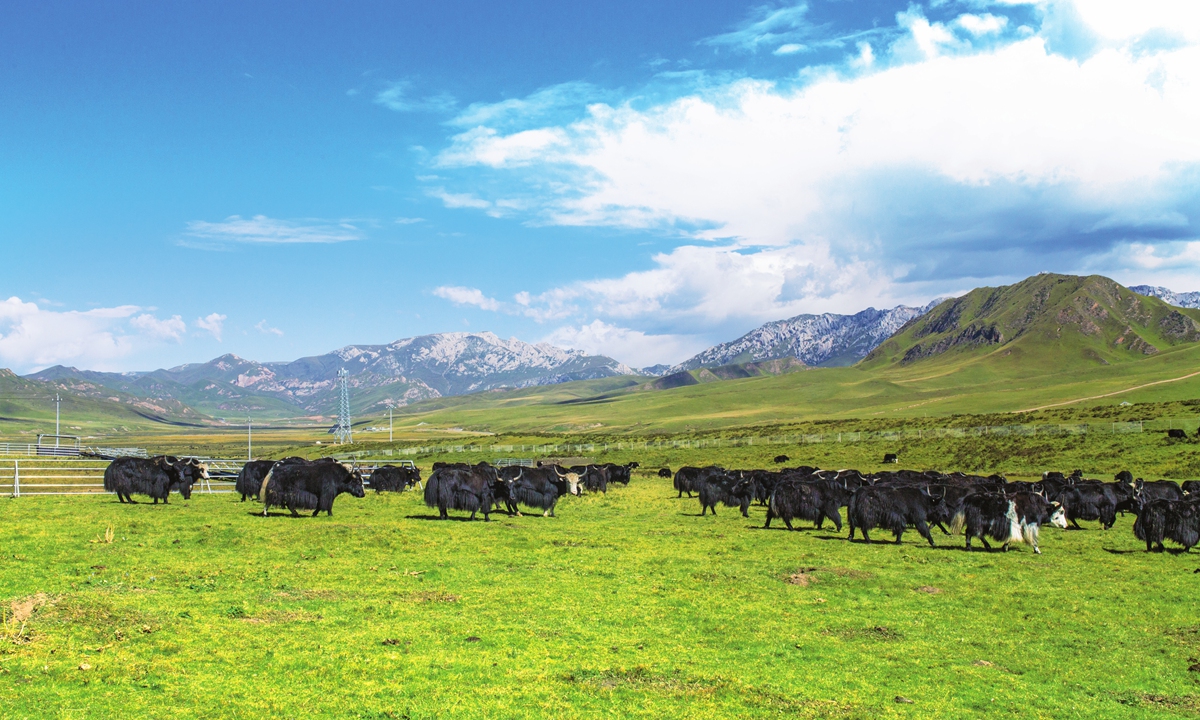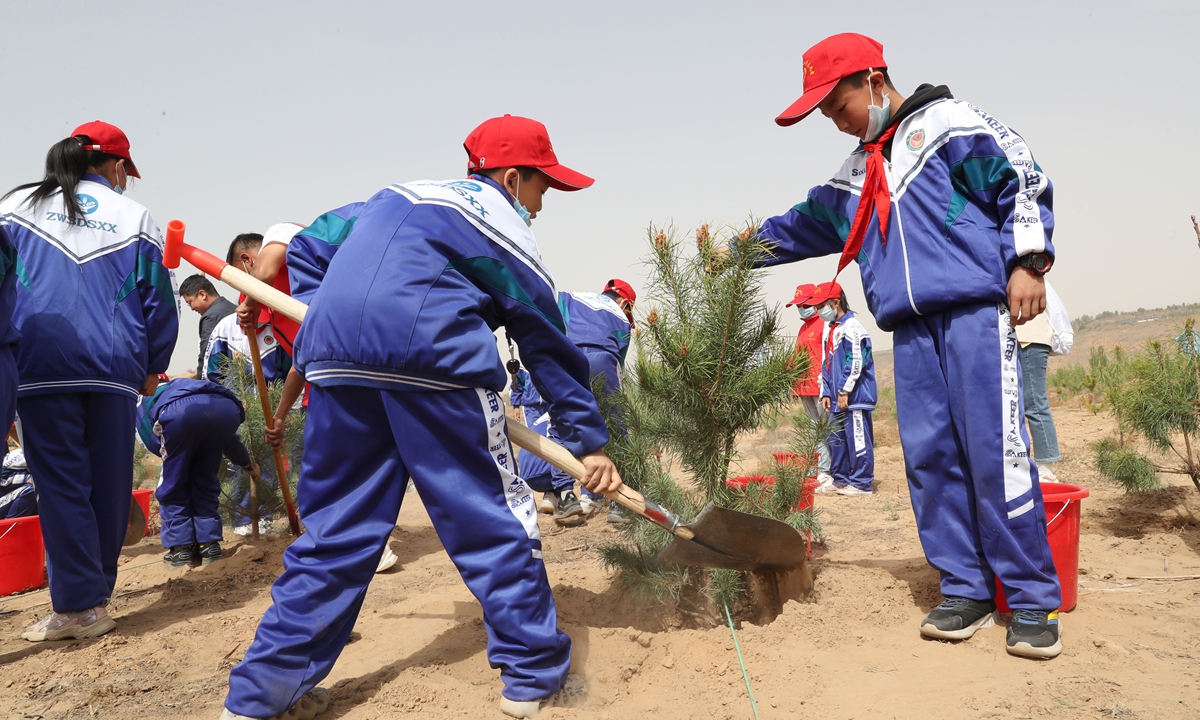Editor's Note: The Yellow River is regarded as the "mother river" of the Chinese nation. Its basin had been a political, economic, and cultural center for thousands of years in the long history of the Chinese civilization. Today, the 5,464-kilometer-long waterway feeds 12 percent of China's population, irrigates 17 percent of all arable land, and supplies water to more than 50 large- and medium-sized cities.
Because of its incomparable historical, cultural, and economic significance, together with its impact to the environment, great efforts must be brought to bear in the protection of the river and its basin. The Global Times will publish a series of stories to show the picture of development along the mother river, and the people's love and happiness.
In this first installment, we retrace our steps back upstream the Yellow River to learn about how local people make efforts to maintain the ecology in the Qinghai-Xizang Plateau and pursue high-quality development.

The Liqiaru Demonstration Ecological Base of Yak in Luqu county, Gannan Tibetan Autonomous Prefecture in Northwest China's Gansu Province Photo: Shan Jie/GT
"The Yellow River comes from heaven!" Chinese poem Li Bai proclaimed with the iconic line a millennium ago.
A thousand years later, we know that the majority of the Yellow River's water comes from Northwest China's Gansu Province - from its origins in the Bayan Har Mountains and as it enters the Qinghai-Xizang Plateau, the river only contains mere 20 percent of its total volume. But as it flows form Qinghai Province through the Gannan prefecture, Gansu, the Yellow River amasses 65 percent of its total volume.
The Gannan Tibetan Autonomous prefecture nourishes the Yellow River with snow-capped mountains, wetlands, and grasslands. It is also known as the kidney of the Yellow River.
Meanwhile, located on the eastern edge of the Qinghai-Xizang Plateau, Gannan is also a herding area used by several ethnic groups and an important animal husbandry production base in China.
In the last few years, a grand campaign of grassland ecological protection and animal husbandry reform has been implemented in the region.
The Global Times reporter recently visited Luqu county in Gannan to witness the efforts invested in conserving the ecological environment of the upstream reaches of the Yellow River and how it has improved people's livelihoods there.
Shield of ecological securityLuqu, meaning "the water of the God" in the Tibetan language, is characterized by Gannan's beautiful mountains and river valleys. Taohe River, the second largest tributary of the Yellow River, passes through the county town, nourishing nearby farms and grasslands.
Natural resources found in the region transformed the area into an essential water conservation and supply area on the upstream of the Yellow River and Yangtze River. It is a natural shield protecting the ecological security of Yellow River Basin.
Luqu faces common ecological problems affecting other regions in the upstream of the Yellow River Basin, such as desertification, grassland overuse, and degradation and soil erosion.
In recent years, the county has designated ecology and environmental protection as priorities for its development, and is seeking to fix the existent problems. Among them are the significant efforts in the reform and upgrade of its traditional animal husbandry techniques.
The Liqiaru Demonstration Ecological Base of Yak is located in a valley 3,900 meters above the sea level. There, hundreds of carefully selected black yaks freely stroll on the rich grassland, with verdant mountains, crystal blue skies, and delicate clouds composing the picturesque background.

The Yellow River
The base is the pioneer and model of Luqu's husbandry reform.
To ease the pressure of natural grassland grazing and accelerate the transformation and upgrade of the animal husbandry, in July 2021, Luqu introduced new technologies and built the demonstration base of Yaks occupying around 13 million squares meters.
The base adopted an innovative and eco-friendly way of raising yaks in a three-tier approach of grazing, pen rearing, and supplemental feeding, which could allow herdsmen to shorten the time of the production cycle, decrease the rate of disease, and improve the taste of meat produced. More importantly, it creates a balance between the grassland ecology and livestock, Li Yuanfeng, the general manager of Gaxiu Agriculture Company, which is running the Liqiaru base, introduced.
This method of raising yaks is being promoted among local herdsmen.
Cai Rangjia, a 26-years-old Luqu resident from the Tibetan ethnic group, has decided to take up the new method developed in Liqiaru base. The shy but determined young man is a rare university graduate in the local area. His return to his hometown encouraged his fellow countrymen in the village.
Now Cai Rangjia has high hopes for the future and has obtained a business license.
"Now people are aware of the importance of ecology," he told the Global Times. "I learned the 'triple combination' breeding method. I used the strategy to breed black feather chicken in my hometown and hope to bring benefits to my folks and build a brand out of it."

Students plant trees at the Yellow River beach in Shapotou district of Zhongwei, Northwest China's Ningxia Hui Autonomous Region on Earth Day on April 22, 2022. Photo: VCG
A better life for localsThe story of Liqiaru base and Cai Rangjia are just a small reflection of Luqu and Gannan's efforts to protect the ecology and environment at the Yellow River's cradle, with which as the priority, the region is seeking to provide better livelihood for its people.
"75 percent of the land in Luqu county belongs to the ecological functional area, which is protected from industrial development. However, we could not just accept the 'blood' (economic aid) from the country; we need to improve our ability to 'create blood,'" Li Shizhong, director of agricultural bureau of Luqu county, told the Global Times.
Despite the Liqiaru base mode, the county is also exploring the co-production system in its rural areas, combining every 10 households to develop animal husbandry and tourism, aiming to consolidate the achievements of poverty alleviation and increase residents' incomes.
After seeing these opportunities, more people are now inspired to return to their hometown.
Once one of China's least developed regions, Gannan has changed its outlook, adopting a green and sustainable path to development with characteristically regional traits.
The whole Gannan prefecture has been incorporated into the national ecological main function area, and more than 97 percent of Gannan's lands are restricted from exploitation.
The prefecture has adopted several key projects to effectively curb the desertification and degradation of grasslands, such as converting grazing land to grassland, restoring degraded grasslands, and building function zones to ensure water supply to the Yellow River.

An aerial view of the Yellow River upstream as it traverses the Aba Tibetan and Qiang Autonomous Prefecture in Southwest China's Sichuan Province Photo: VCG
Moreover, the region has initiated an aggressive campaign to realize a "no waste, no chemical fertilizers, no plastics, no pollution, and no public hazard" goal, further upgrading green development.
Featuring various landscapes and colorful cultures, Gansu Province has become a great attraction among tourists from home and abroad. In 2021, the comprehensive tourism revenue of Gannan prefecture will exceed 10 billion yuan, maintaining double-digit growth for five consecutive years.
Its Gahai wetland, a key wetland in the prefecture in the Qinghai-Xizang Plateau, has become home to some endangered migrant bird species over the years thanks to its improving ecological environment. It's now breeding season for the migratory birds here which are expected to successfully hatch chicks.







